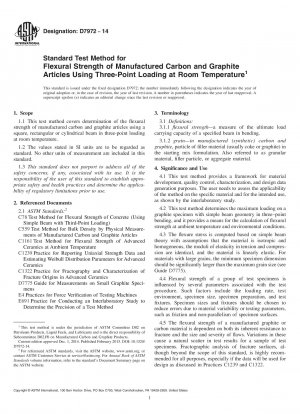ASTM D7972-14
Standard Test Method for Flexural Strength of Manufactured Carbon and Graphite Articles Using Three-Point Loading at Room Temperature
- Standard No.
- ASTM D7972-14
- Release Date
- 2014
- Published By
- American Society for Testing and Materials (ASTM)
- Status
- Replace By
- ASTM D7972-14(2020)
- Latest
- ASTM D7972-14(2020)
- Scope
4.1 This test method provides a framework for material development, quality control, characterization, and design data generation purposes. The user needs to assess the applicability of the method on the specific material and for the intended use, as shown by the interlaboratory study.
4.2 This test method determines the maximum loading on a graphite specimen with simple beam geometry in three–point bending, and it provides a means for the calculation of flexural strength at ambient temperature and environmental conditions.
4.3 The flexure stress is computed based on simple beam theory with assumptions that the material is isotropic and homogeneous, the moduli of elasticity in tension and compression are identical, and the material is linearly elastic. For materials with large grains, the minimum specimen dimension should be significantly larger than the maximum grain size (see Guide D7775).
4.4 Flexural strength of a group of test specimens is influenced by several parameters associated with the test procedure. Such factors include the loading rate, test environment, specimen size, specimen preparation, and test fixtures. Specimen sizes and fixtures should be chosen to reduce errors due to material variability or testing parameters, such as friction and non-parallelism of specimen surfaces.
4.5 The flexural strength of a manufactured graphite or carbon material is dependent on both its inherent resistance to fracture and the size and severity of flaws. Variations in these cause a natural scatter in test results for a sample of test specimens. Fractographic analysis of fracture surfaces, although beyond the scope of this standard, is highly recommended for all purposes, especially if the data will be used for design as discussed in Practices C1239 and C1322.
4.6 The three-point test configuration exposes only a very small portion of the specimen to the maximum stress. Therefore, three-point flexural strengths are likely to be much greater than four-point flexural strengths. Three-point flexure has some advantages. It uses simpler test fixtures, allowing small specimen testing and fracture toughness measurements. However, four-point flexure is preferred and recommended for most characterization purposes.
1.1 This test method covers determination of the flexural strength of manufactured carbon and graphite articles using a square, rectangular or cylindrical beam in three-point loading at room temperature.
1.2 The values stated in SI units are to be regarded as standard. No other units of measurement are included in this standard.
1.3 This standard does not purport to address all of the safety concerns, if any, associated with its use. It is the responsibility of the user of this standard to establish appropriate safety and health practices and determine the applicability of regulatory limitations prior to use.
ASTM D7972-14 Referenced Document
- ASTM C1161 Standard Test Method for Flexural Strength of Advanced Ceramics at Ambient Temperature
- ASTM C1239 Standard Practice for Reporting Uniaxial Strength Data and Estimating Weibull Distribution Parameters for Advanced Ceramics
- ASTM C1322 Standard Practice for Fractography and Characterization of Fracture Origins in Advanced Ceramics
- ASTM C559 Standard Test Method for Bulk Density by Physical Measurements of Manufactured Carbon and Graphite Articles
- ASTM C78 Standard Test Method for Flexural Strength of Concrete (Using Simple Beam with Third-Point Loading)
- ASTM D7775 Standard Guide for Measurements on Small Graphite Specimens
- ASTM E4 Standard Practices for Force Verification of Testing Machines
- ASTM E691 Standard Practice for Conducting an Interlaboratory Study to Determine the Precision of a Test Method
ASTM D7972-14 history
- 2020 ASTM D7972-14(2020) Standard Test Method for Flexural Strength of Manufactured Carbon and Graphite Articles Using Three-Point Loading at Room Temperature
- 2014 ASTM D7972-14 Standard Test Method for Flexural Strength of Manufactured Carbon and Graphite Articles Using Three-Point Loading at Room Temperature
